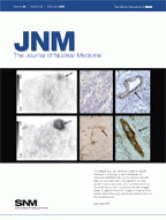Index by author
Cover image

The integrin αvβ3, an interesting target for specific therapies in oncology, is highly expressed on activated endothelial cells during angiogenesis and plays an important role in the regulation of tumor growth, local invasiveness, and metastatic potential. As confirmed by the immunohistochemistry images, these 18F-galacto-RGD PET images of invasive ductal breast cancer show αvβ3 expression predominantly on the neovasculature.
See page 255.



